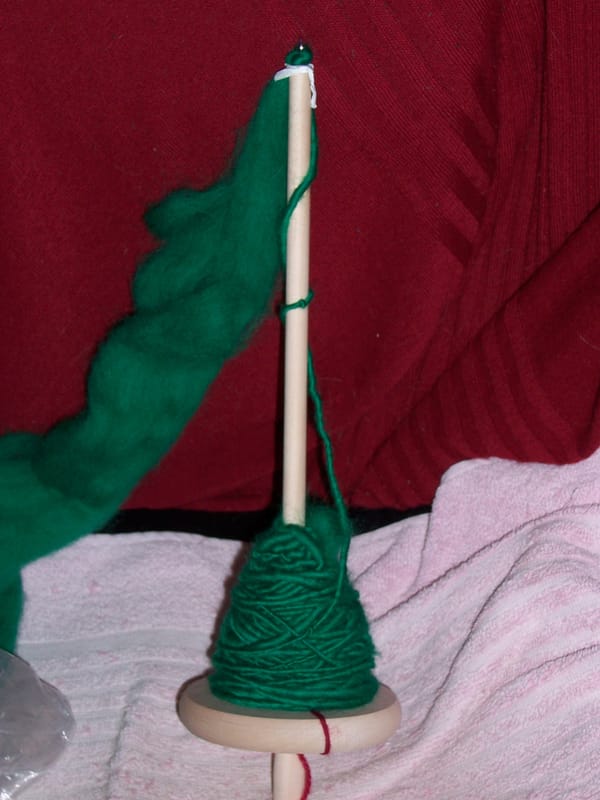Theme and variations

I may have mentioned that the demographic is a bit odd here. At one point I heard that there were more under-1s in this town than over-55s; that may have changed, since it is now more than a year since I heard that particular snippet, but it is true that the population here skews pretty young by comparison with the UK average, and there are also still a lot of babies being born. And these babies need clothes; and, sadly, their parents don't always have enough money to put food on the table, let alone provide good ones.
That's where the local food bank comes in. I think it's an absolute scandal that food banks should have to exist in this country, but, since they do, I volunteer at one (and have been doing since the day it opened). And the thing with food banks is that we don't just give out tinned and other long-life food, though that is the basis of what we provide. People also need a lot of other things. Exactly what is given out depends very much on the local food bank network and also the population mix in the area (recently, for instance, we've had a lot of large refugee families who have been moved into the town, and most of them are Muslim, so we've been cleaning our local supply network out of halal food every week for a while now), but you can usually guarantee that there are going to be laundry/cleaning materials and at least a few toiletries. Ours has access to a fridge, so we can also give out packaged cheese and cooked meat, and for quite a while we had fresh bread available because there was a lady who baked it at home and sold it from a van, and she would give us the leftovers. (Sadly she is no longer in business.) Because of the number of babies in the area, nappies are another very popular staple, and we sometimes also have baby wipes, though they're not guaranteed, as it does depend on what people give. And then, of course, people do have pets, and it's hardly fair to expect them to give them up just because they have fallen on hard times, so we have cat and dog food too. A little unusually, we also do books, which a lot of our visitors really appreciate; it started with someone giving us a large donation of books because they'd had a clear-out, and then, once it became known that we do books, other people also started bringing them in.
And then there's the knitting.

I started out by knitting jumpers, and I'd do one every week - acrylic from about September to April, and cotton for the rest of the year. I have about a dozen baby jumper patterns, all (of course!) featuring cables, and I'd just cycle through those, usually alternating the sizes; I knit for babies up to a year old, so one week I'd do a 0-6 months size and then the next I'd do a 6-12 months (unless we had a run on one size, in which case I'd do a few more of that size to compensate). They were popular, but they never went at the rate of one a week, so quite a few of them ended up going on lorries to Ukraine, which was absolutely fine by me. But then, after a while, someone said to me, "You know, you should knit hats. Baby hats are really in demand, and all year round too!"
"Fine," I said. "I'll knit hats. They're a lot quicker than jumpers."
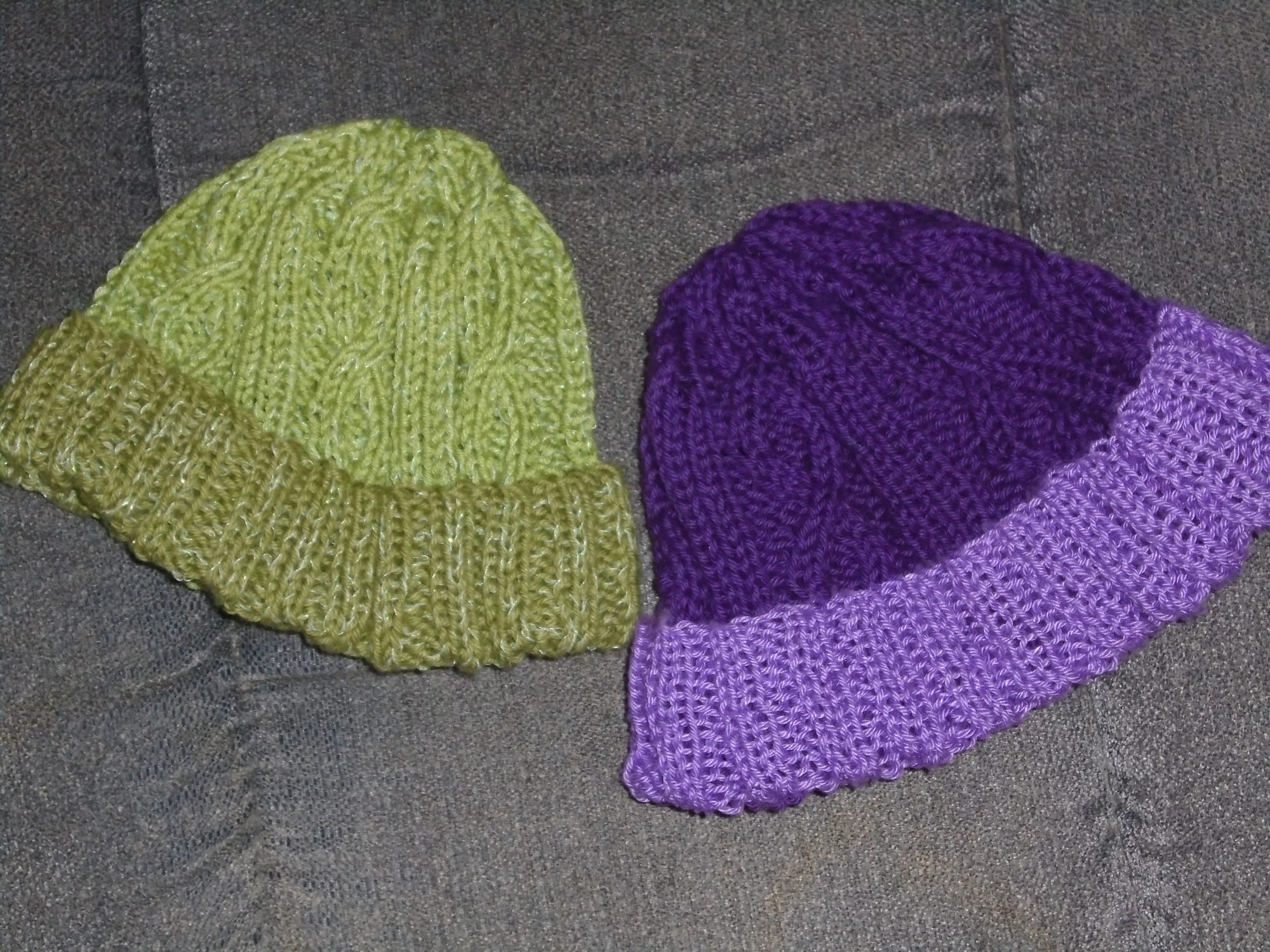
I thought I had a whole stack of baby hat patterns; but in fact I didn't. I had maybe three or four. One of them was a Rudolf the Red-Nosed Reindeer hat, so perfectly useless outside the Christmas season, and the others were surprisingly boring. So, nothing daunted, I designed this one, and here's the pattern. Once again, apologies for not laying it out neatly; if I find a way round the automatic blank line insertion, I promise you'll be the first to know. The pattern is for the 0-6 months size; figures in square brackets are for the 6-12 months size. The gauge is DK.
Using 3.25 mm needles, cast on 90 [94] sts and work 5 cm in k2, p2 rib. Change to 4 mm needles (and main colour, if you're doing a contrast welt as I usually do), then: p3 [5], (k4, p4, C4B, p4) to last 7 [9] sts, k4, p3 [5]. On all even rows, work the stitches as you find them (ie knit the knit stitches and purl the purl stitches). 3rd row: p3 [5], (k4, p3, T3B, T3F, p3) to last 7 [9] sts, k4, p3 [5]. 5th row: p3 [5], (k4, p2, T3B, p2, T3F, p2) to last 7 [9] sts, k4, p3 [5]. 7th row: p3 [5], (k4, p2, T3F, p2, T3B, p2) to last 7 [9] sts, k4, p3 [5]. 9th row: p3 [5], (k4, p3, T3F, T3B, p3) to last 7 [9] sts, k4, p3 [5]. The pattern repeats every 10 rows. Continue till work measures 14 [15] cm in total, ending on a wrong side row. (Hint: it's easiest if you end on a row which is not a multiple of 4. That just makes the subsequent decreases a little easier - you don't have to include any stitches in both a cable and a decrease at the same time.)
Now you're going a little freestyle. Over the next 10 rows, you need to decrease - on the odd rows only - but exactly how you do that depends on where you are in the pattern. My standard practice is that on the first decrease row I decrease on the knit ribs, so over those four stitches I'll do skpo and then k2tog, then I get rid of two stitches per pattern repeat on the next three decrease rows (as far as possible by working them into the newly narrowed knit ribs), and then on the last row I do a k2tog on all the cable strands and get rid of any intervening stitches that happen to come in convenient pairs. Then you just work the final wrong side row, thread the yarn through the remaining stitches, tighten it up, and sew the side seam.

These little things are wonderful for experimenting with different colours and effects. I almost always do a contrast welt, and often that's marled, because (as I've mentioned previously) you can use two strands of 4-ply instead of one strand of DK.

I usually like to make the welt darker than the body of the hat, because lighter colours show off the cables better; but I don't always do that, as you see from the purple hat some way above.
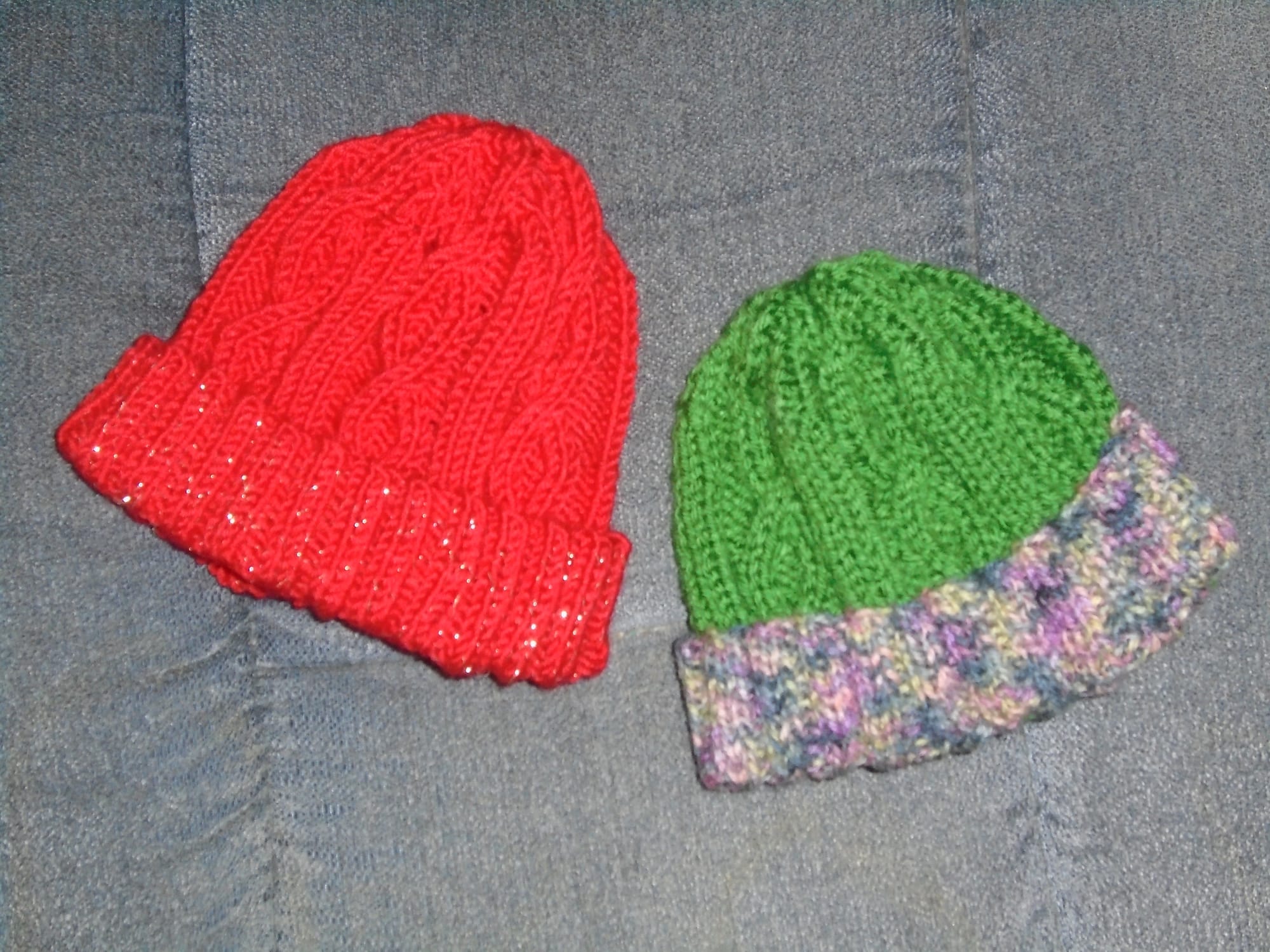
The one on the right in the above photo looks a lot better in real life, because my camera is inclined to blue things somewhat. The actual hat is an optical illusion. The colours in the random yarn are pink (not purple!), yellow, and grey, and if you team it up with green it really does look as if there is green in it.
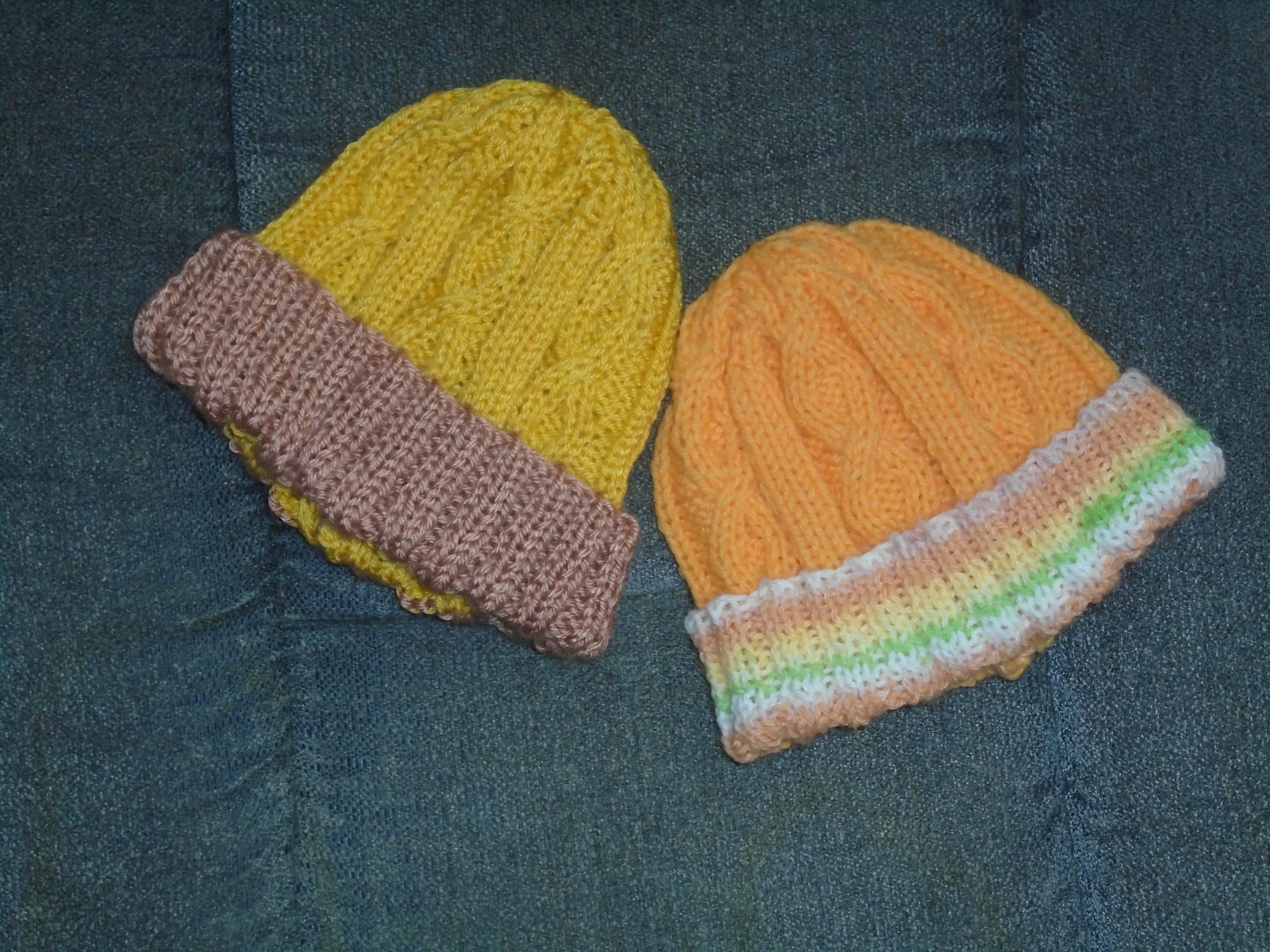
Having had fun with one random yarn, I tried another, but I was a little disappointed with this. If I use a random yarn, I want irregular streaks of colour, not neat stripes; I can knit those for myself. Still, it does tone nicely with that orange.
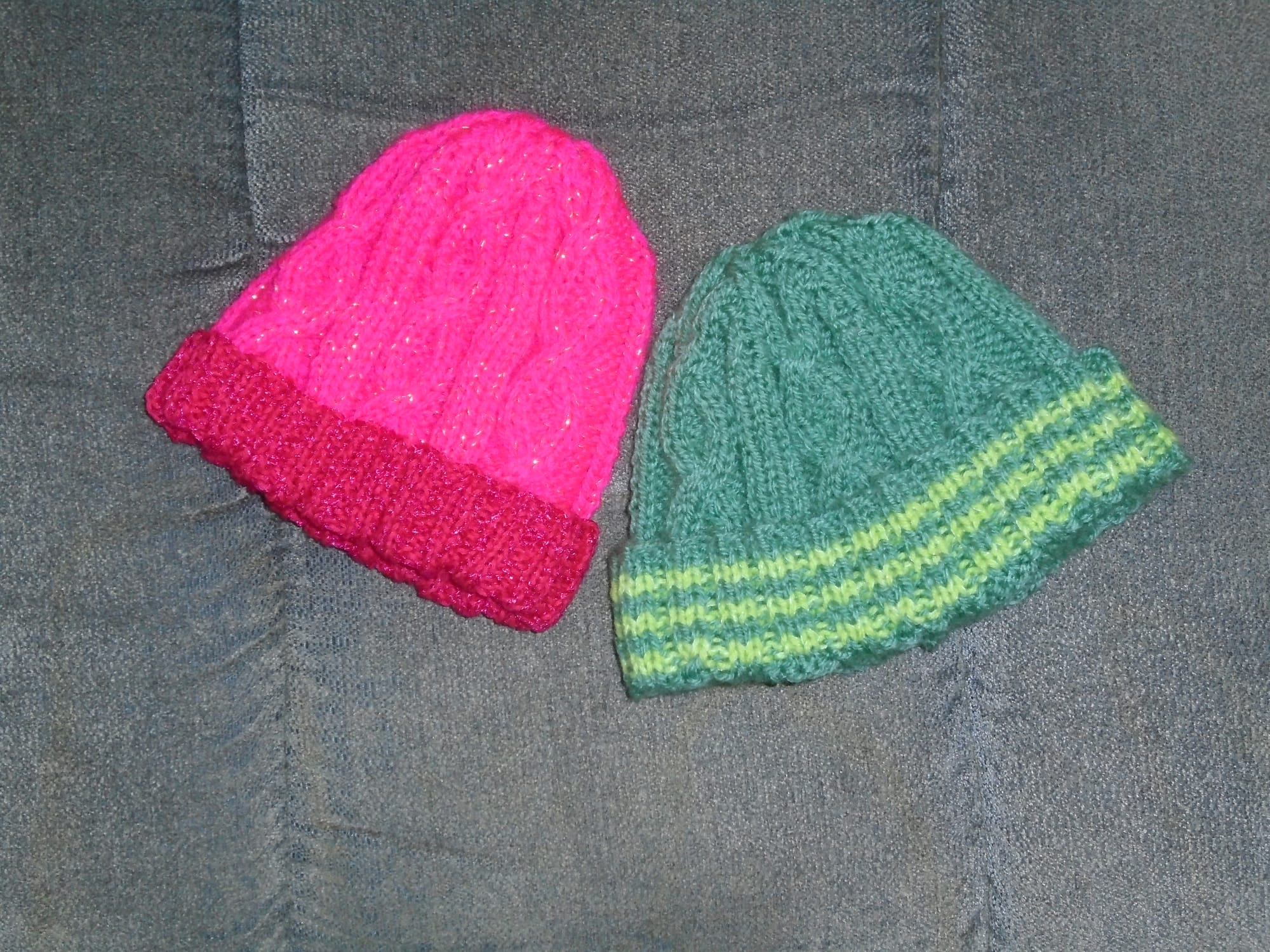
The hat on the left isn't such a contrast as it appears; the yarn I used for the welt is Paintbox Metallic in Sangria, and if you look at that closely it's a true red combined with a shade that is definitely leaning quite hard towards fuchsia, so it does go well with the bright pink yarn.

Ah, yes. That rather pallid mint green yarn (probably bought in error, as I don't really do pastels). It needed livening up; would it look better with the metallic silver or the pearlised green filament? Simple: work the first into the welt and the second into the body. I'm still undecided.
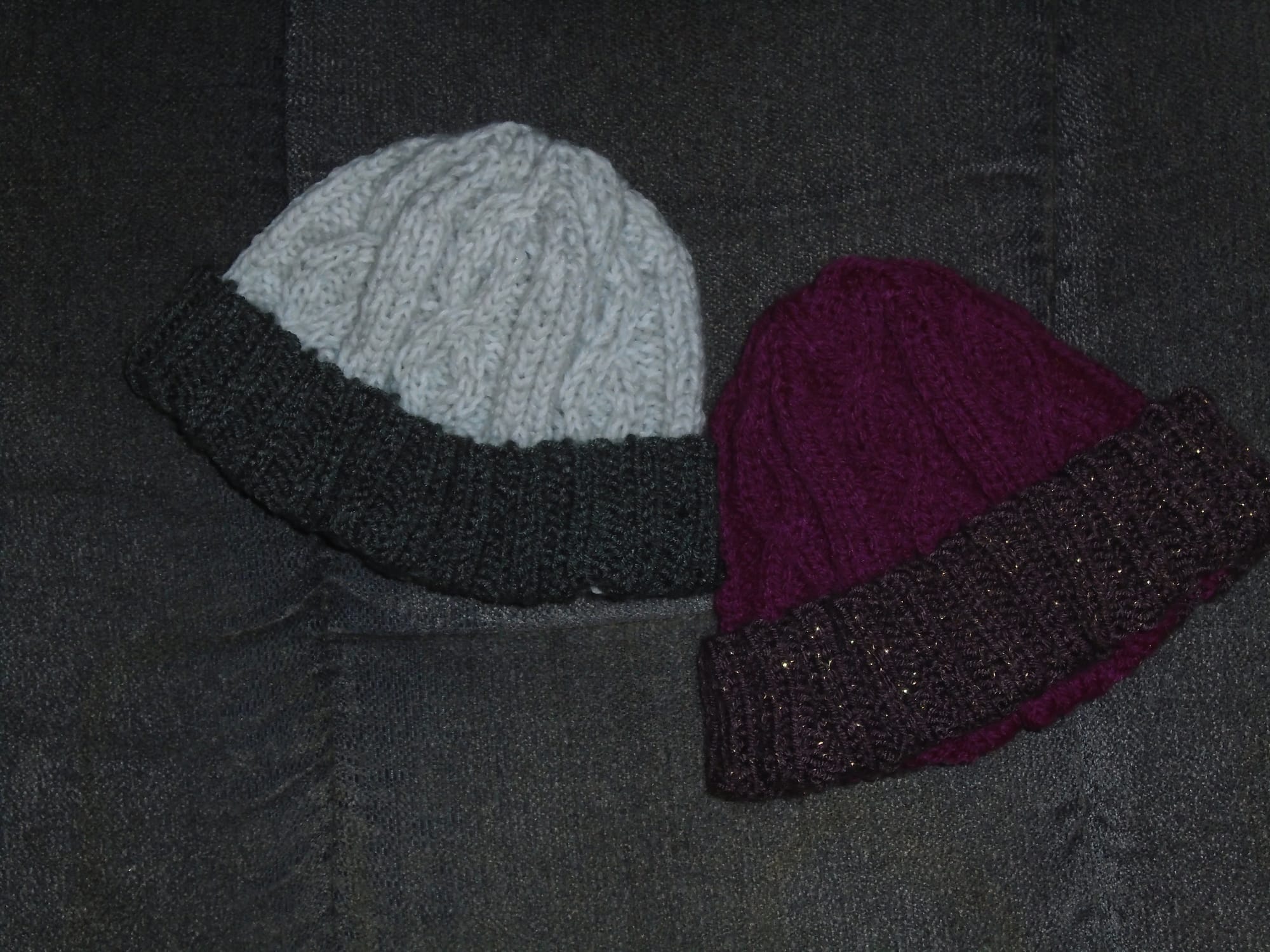
And now you see where I got the idea to use those two strands of Sirdar Snuggly 4-ply to knit my weird little ear cosy. I'd just made the hat on the left and liked it so much I couldn't resist.
OK, so that's the baby hats, and if we have too many at the food bank there's apparently also a huge demand for them at the local maternity hospital. As for the food bank:
Your local branch will be immensely grateful for any help you can give. Even if you can't give anything else, we love good strong bags; our visitors don't always remember to bring their own in (though the refugee families are great - they've all got those two-wheeled shopping trolleys). Not the flimsy ones - you can recycle those through Ocado if you know anyone who shops with them; I think at least some other supermarkets do the same. If you want to donate food, anything that keeps is welcome, so - tins, packets of things like rice and pasta, long-life milk and juice, jars of almost anything (our branch tends to struggle a little for pasta sauce, so that's a good option if you're stuck; but also jam, nut butter, honey, pickles, whatever), bags of sugar, sweets, biscuits, herbs, spices, tea, coffee, salt, and pepper. Also welcome are soap, toothbrushes/toothpaste, loo rolls (we give out scads of those), nappies, sanitary protection, laundry and cleaning products, pet food, and occasionally larger items; someone once gave us half a dozen slow cookers, which we handed out and were received with delight. The one proviso is that all food products have to be in date. Tinned food does pretty much last for ever, but if the date on the tin has expired we can't legally hand it out (in which case, one of the volunteers will probably take it).
There are also usually volunteering opportunities available, and not just in the food bank itself - there will also be a central warehouse somewhere, and people are needed there to help pack the food into crates and deliver it to the individual centres. Mostly you do need to be fairly fit (each crate of food weighs about 15 kg; a single person or a couple gets one crate, a family of three or four gets two which are organised as a pair, and if there are more people you add on as required), but if you're like me and can't do heavy lifting, there are still things you can do. What I do is I pack bags, and sometimes check labels to make sure things are halal/gluten-free/whatever is specifically needed.
Or you could knit!


